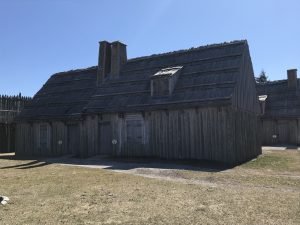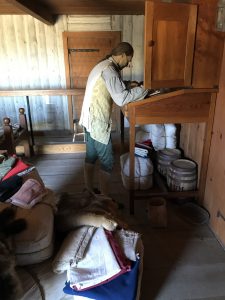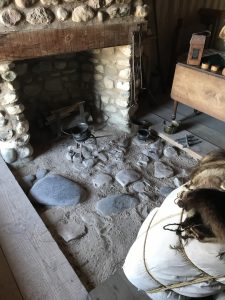With Passover underway, let’s take a closer look at one of Michilimackinac’s merchants: Ezekiel Solomon, who was probably Michigan’s first Jewish resident.

Originally from Berlin, Solomon immigrated to Canada and became a sulter for the British army during the Seven Years’ War. He later formed a partnership with several other Jewish men, including his cousin Levy Solomon, Chapman Abraham, Benjamin Lyon, and Gershon Levy, and beginning in 1761 the partners spread out across the Great Lakes. While Lyon remained in Montreal, Levy Solomon went to Fort Niagara, Abraham went to Detroit, and Ezekiel Solomon and Levy pushed the farthest west, setting up shop at Michilimackinac. By distributing themselves at these critical points, the partners ensured a continuous flow of furs and trade goods between Montreal and the distant trading grounds of the Great Lakes. Eager to be among the first to tap into the lucrative Michilimackinac fur trade following the British conquest of Canada, Solomon joined Alexander Henry and a few other British merchants at the post even before British troops arrived to formally occupy the Straits of Mackinac. Solomon and his partners were very successful during the first years of British rule in Canada, but he lost great deal of merchandise when the local Ojibwa captured Michilimackinac during the surprise attack of June 2, 1763. Solomon survived by hiding in an attic but watched as his French Canadian neighbors used the confusion of the attack as an opportunity to break into and loot his trade goods. Solomon and his partners ultimately lost £18,000 worth of goods in the attacks at Michilimackinac and other British posts around the Great Lakes. Thanks to the intervention of the local Odawa, Solomon, along with the other Michilimackinac survivors, were sent to Montreal after the attack.
The British returned to Michilimackinac and the other Great Lakes posts in 1764, and a year later Solomon and Levy purchased a house in a rowhouse in the southeast corner of the fort. Their purchase also included a cabin and stable with horse and carriage, but it is unclear where these were located. In any case, despite the disruption of the attack, Solomon and Levy returned to their positions as successful merchants. Although Levy disappears from the historical record around 1768, Solomon continued sending out three or four canoes per season to the western trading grounds. He typically lived at Michilimackinac during the summer to supervise his voyageurs and the transshipment of his goods, returning to another house he owned in Montreal during the winter. During the winter of 1766-67, however, he lived among the Sioux of the far western Great Lakes, trading directly with them and other indigenous people. Thanks to this and other trade alliances, Solomon became one of the leading merchants trading at Lake Nipigon on the north shore of Lake Superior.

Solomon married Louise Duboise, a French-Canadian Catholic, in Montreal in 1769. They eventually had several children together, all of whom were raised as Catholics. When a son died in 1778, however, Solomon petitioned the leadership of the Shearith Israel Synagogue for permission to bury him in the congregation’s Montreal cemetery. The request was granted, perhaps in part due to Solomon’s standing as a leader in the Shearith Israel community. He helped draft some of the synagogue’s founding documents, contributed to the purchase of two Torahs, and in 1778 held the post of Hatan Torah. During the final Torah reading in the annual cycle, the Hatan Torah received the final aliyah, or call to the Torah, making it a position of honor and esteem.
Although no specifically Jewish objects were recovered when Mackinac State Historic Parks archaeologists excavated Solomon’s house at Michilimackinac in 1983-88 (being important personal objects, any religious pieces were probably moved from the house when it was abandoned during the move to Mackinac Island in 1781), his roles in the Shearith Israel community speak to his faith. An incident in Montreal in 1775 also reveals Solomon’s feelings about his Jewish heritage. On May 1, when the Quebec Act went into effect, the citizens of Montreal awoke to discover that the city’s statue of George III had been defaced. The act was unpopular with some of Montreal’s British merchants, who viewed it as both a detriment to their business and too permissive of Canadian Catholics. As a result, someone blackened the face of the statue’s face, and hung a rosary made of potatoes from its neck along with a sign that read “Behold the Pope of Canada or the English fool.” British officers offered a reward for the capture of the culprit. Overhearing a debate about potential perpetrators, Solomon intervened when a man suggested a Jew was responsible for the vandalism. When the man continued making antisemitic remarks, Solomon punched him hard enough to knock him down. Although arrested, Solomon apparently suffered no lasting effects for defending his faith.
Solomon continued trading at Michilimackinac during the American Revolution. In 1778 he joined many other merchants in the community in drafting a petition for the installation of a permanent priest at Ste. Anne’s Church, where there had not been a resident clergyman since 1765. Solomon even subscribed money to the effort, but the petition was ultimately unsuccessful. When Lieutenant Governor Patrick Sinclair decided to move the entire community to a more defensible location on Mackinac Island beginning in 1779, Solomon’s house and the adjoining rowhouse units were demolished, rather than relocated and rebuilt. He and Louise gave up their Montreal home, moving to a new house on Mackinac Island in 1781. Louise remained active in the relocated Ste. Anne’s congregation on the island. The surviving Solomon children, including daughter Elizabeth and sons Guillaume and Samuel, were also active members of the parish, serving as godparents for the children of other members. Guillaume and Samuel followed in Ezekiel’s footsteps as traders, and each had relationships with multiple indigenous women (Guillaume fathered children with three different women), which usually served to strengthen business alliances with the woman’s family.

Ezekiel Solomon himself died sometime between 1804 and 1808. When archaeologists began excavating his house at Michilimackinac in the 1980s, Solomon family descendants traveled to Mackinaw City to see where their ancestor had lived. Some volunteered to help with the excavation which was featured in the New York Times. Today, the rowhouse in which Solomon and Levy purchased a house in 1765 has been partially reconstructed, and visitors can explore the two-room home that served as their base of operations at Michilimackinac. In addition to trade goods and other artifacts recovered from the other, modern visitors can also look down into Solomon’s intact cellar and see parts of the original structure, including wall remains and the hearth. We hope you’ll join us soon at Michilimackinac to learn more about Ezekiel Solomon and his role in the community. Visit our website for tickets and more information, and be sure to also check out Mackinac Associates, a friends group which makes many of our programs and exhibits possible.









